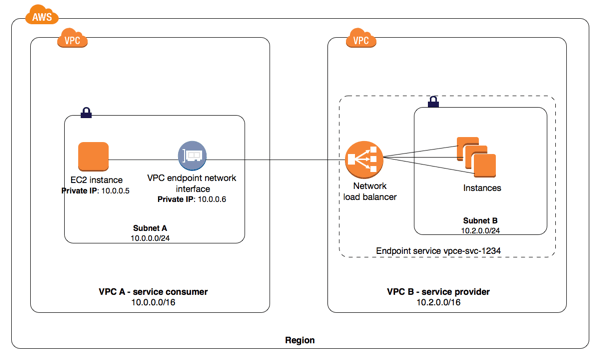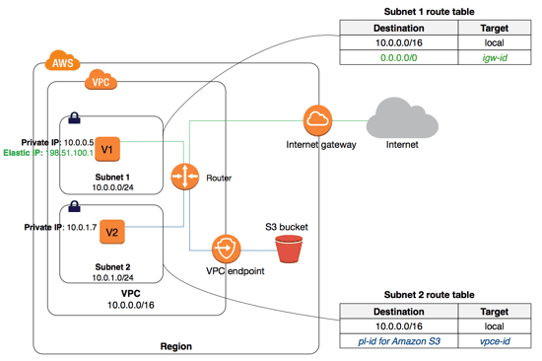How Many Of Aws Service Have Vpc Endpoints
Network security is disquisitional to operating in the deject. There are many different ways you can secure your network, simply the all-time approach is to layer multiple methods. The more layers implemented in your security, the harder it is for malicious actors to admission your network.
In a three part blog series, we will focus on several "layers" of practicing defense in depth. This first blog discusses VPC endpoints - what they are, how they work, limitations of using endpoints, and how they tin help ameliorate network security.
For the security-minded, Amazon Spider web Services VPC endpoints nowadays a safer way to allow network resources to connect to other AWS services. Prior to the introduction of endpoints, VPC resource had to go out to the net to communicate with certain services. This poses a potential security and availability gamble, and complicates infrastructure architecture.
Now, VPC endpoints allow traffic to flow between a VPC and other services without ever leaving the Amazon network. This introduces a number of benefits, not the to the lowest degree of which is improved network security.

What is a VPC endpoint?
An endpoint is a network component that connects EC2 instances in a VPC to certain AWS services without requiring public IP addresses. With a VPC endpoint, instances don't need a NAT device, VPN connection, internet gateway, or AWS Straight Connect to communicate with supported services — they can communicate solely within AWS.
In that location are two types of VPC endpoints:
- Interface endpoints
- Gateway endpoints
Both types keep traffic within the AWS network, but support different services and piece of work in different ways. The destination service dictates which endpoint type yous should use — meet the AWS documentation for details.
What are AWS VPC interface endpoints?
An interface endpoint is an elastic network interface that allows a private IP address in a subnet to connect VPC resource to a number of AWS services, such as CloudFormation, Elastic Load Balancers (ELBs), SNS, and more than.
Interface endpoints also let VPC resources connect to supported AWS Marketplace partner services in addition to endpoint services, which are hosted by AWS customers or partners in their own VPCs.
Traffic from VPC resources to the endpoint network interface is controlled by security group rules. AWS PrivateLink then enables the endpoint to connect the traffic to other services without going over the cyberspace.
AWS charges usage and data processing rates for PrivateLink, and so at that place are additional costs involved with creating and using an interface endpoint.
How practice AWS VPC interface endpoints work?
When you cull one or more subnets in a VPC to use your interface endpoint, AWS creates an endpoint network interface in each selected subnet.
Next, y'all associate security groups with the endpoint network interface. The security group must have a dominion allowing communication between the endpoint network interface and the resources in the VPC that need to connect to the service.
You can then optionally enable individual DNS when connecting to the service, which allows requests to use the default DNS hostname instead of endpoint-specific hostnames. Private DNS is enabled by default for AWS and AWS Marketplace services.
Finally, the owner of the service, such as AWS itself or a third political party from the Marketplace — known as the service provider — either manually or automatically accepts endpoint requests from y'all, the service consumer.
Accepted endpoint requests are and then privately continued to the service.
Interface endpoints besides allow you to adhere an endpoint policy controlling access to the service.

Above, instances in subnet A of VPC A use an interface endpoint to admission the services in subnet B. Image from https://docs.aws.amazon.com/vpc/latest/userguide/endpoint-service.html
What are AWS VPS gateway endpoints?
In contrast, a gateway endpoint is a target for a route in a route table to connect VPC resources to S3 or DynamoDB. Traffic is so routed from instances in a subnet to ane of these two services.
A VPC may have multiple gateway endpoints to unlike services in a route table or multiple gateway endpoints to the same service in dissimilar road tables, but it may not have multiple gateway endpoints to the aforementioned service in the same road table.
Gateway endpoints do not use PrivateLink. Therefore, apart from the standard costs of data transfer and resource use, AWS doesn't charge actress for using gateway endpoints, different interface endpoints.

How do AWS VPC gateway endpoints work?
To gear up a gateway endpoint, you specify the VPC and the service its resource will connect to. Every bit with interface endpoints, you may specify a policy for the gateway endpoint to command access to the service.
So, you specify the route tabular array(southward) where routes to the service will be created. Each created route has a destination fix to the service prefix list ID and a target set to the endpoint ID.
Subnets associated with the route tables are automatically granted access to the endpoint, and traffic from instances in the subnet is routed through the endpoint to the service according to the endpoint policy. The default policy allows full admission from whatever credentialed user or service within the VPC to S3 or DDB resources.
A VPC security grouping must have a rule assuasive outbound traffic from the VPC to the specified service (S3 or DDB) in gild for traffic to flow through a gateway endpoint.

Higher up, instances in subnet two can access Amazon S3 through the VPC gateway endpoint. Image from https://docs.aws.amazon.com/vpc/latest/userguide/vpce-gateway.html
VPC endpoints can improve network security
The biggest reason VPC endpoints are benign to network security is that there's no demand for VPC resources to traverse the internet to reach a detail service. By preventing information from existence unnecessarily exposed to the internet, it's easier to secure network traffic and ensure it remains compliant with standards such equally PCI or HIPAA that business organisation sensitive data.
VPC endpoints likewise simplify infrastructure compages. For example, you lot can apply an interface endpoint to connect traffic from an case to a service such as SQS, or you can:
- Configure an internet gateway
- Configure security group or network ACL rules
- Fix route tables
- Risk compromising your sensitive data
You can use a gateway endpoint to connect traffic from a private subnet to a service such equally S3, or yous can:
- Create a public subnet
- Launch an EC2 instance with an internet gateway or NAT device
- Road traffic to the internet to ultimately connect to S3
- Risk compromising your sensitive data
Additionally, VPC endpoints keep communication within AWS, which prevents availability risks and bandwidth constraints on your network traffic.
The limitations of VPC endpoints
In that location are a few items worth noting when using VPC endpoints:
- The VPC endpoint and service must exist in the same region
- VPC endpoints back up IPv4 traffic only
- Endpoints can't be transferred from one VPC or service to another
- S3 bucket policies can exist used to control access to buckets from specific gateway endpoints or VPCs
- DynamoDB doesn't support resource-based policies, so access is merely controlled through the gateway endpoint and user/role/group IAM policies
For more information on endpoint limitations, see the AWS documentation for interface endpoints and gateway endpoints.
VPC endpoints: Simply one role of defence force in depth
VPC endpoints are one chemical element of a defence in depth approach to network security. Combined with tightly scoped security group and network ACL rules; IAM user/group/part, resources, and endpoint policies; and other methods of VPC security, you tin effectively limit the exposure of critical data to the internet and more than effectively secure your network.
To larn more about Fugue and how we can assistance with your cloud security, delight visit fugue.co.

Source: https://www.fugue.co/blog/network-security-vpc-endpoints-101
Posted by: shryockoffirtansay1992.blogspot.com


0 Response to "How Many Of Aws Service Have Vpc Endpoints"
Post a Comment